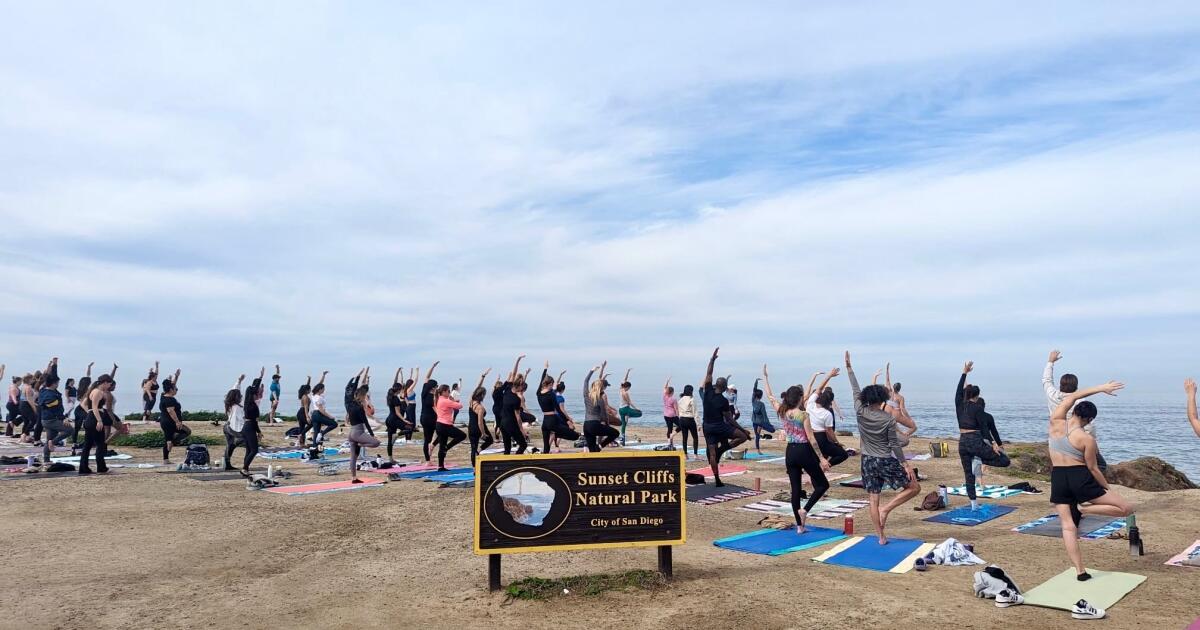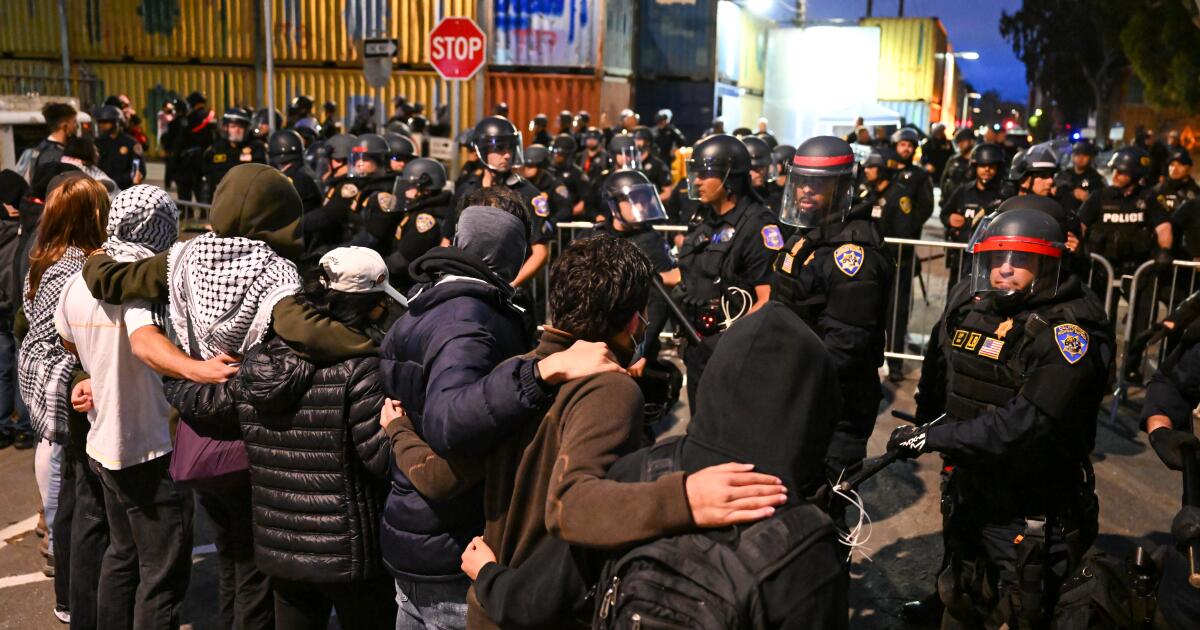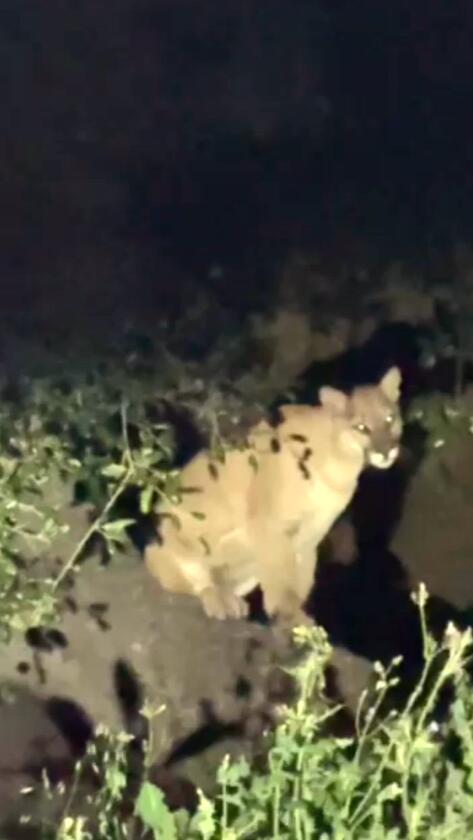World News
‘Are you a Zionist?’ UCLA checkpoints provoked fear, debate for Jews

Eilon Presman was about 100 feet from the UCLA Palestinian solidarity encampment when he heard the screams: “Zionist! Zionist!”
The 20-year-old junior, who is Israeli, realized the activists were pointing at him.
“Human chain!” they cried.
A line of protesters linked arms and marched toward him, Presman said, blocking him from accessing the heart of UCLA’s campus. Other activists, he said, unfurled kaffiyeh scarves to block his view of the camp.
“Every step back that I took, they took a step forward,” Presman said. “I was just forced to walk away.”

Pro-Palestinian activists demonstrate in UCLA’s Bruin Plaza after arrests were made at the Westwood campus Monday.
(Brian van der Brug / Los Angeles Times)
It’s been a week since police swarmed the UCLA campus and tore down the pro-Palestinian camp, arresting more than 200 people. But the legacy of the encampment remains an issue of much debate, particularly among Jewish students, who make up nearly 8% of the university’s 32,000 undergraduates.
In the days leading up to April 30 — when pro-Israel counterprotesters attacked the camp with fists, bats and chemical spray, and police took hours to stop the violence — frustration had swelled among many Jews: Viral videos showed activists restricting the passage of students they targeted as Zionists.
Some Jewish students said they felt intimidated as protesters scrawled graffiti — “Death 2 Zionism” and “Baby Killers” — on campus buildings and blocked access with wooden pallets, plywood, metal barricades and human walls.
The pro-Palestinian student movement includes various strains of activism, including calls for a cease-fire in Gaza, support for Hamas and demands that universities divest from firms doing business with Israel. But on campuses across the country, no word has become more charged than “Zionist.”
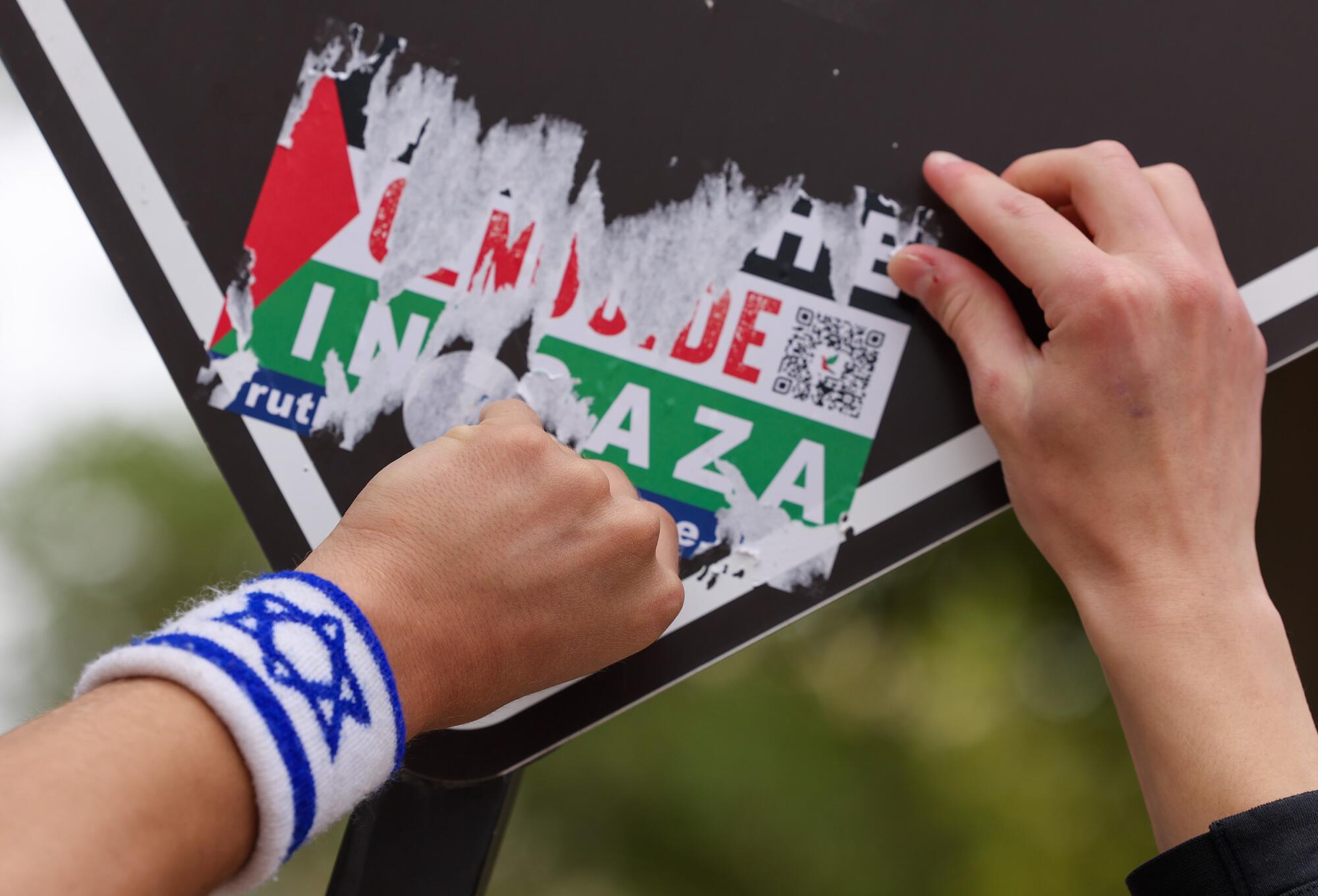
A pro-Israel activist peels a pro-Palestinian sticker off a sign on May 2 as a protest encampment was dispersed.
(Brian van der Brug / Los Angeles Times)
In its most basic definition, a Zionist is somebody who believes that the Jewish people have a right to statehood in their ancestral homeland as a place of refuge from centuries of persecution — in other words, that Israel, established as a Jewish state in the wake of the Holocaust, has a right to exist.
Using that definition, the Anti-Defamation League considers anti-Zionism a form of antisemitism. But protesters — including many Jews — draw a sharp distinction, arguing that it is Zionism that fuels Israel’s right-wing government and the assault on Gaza that they say amounts to genocide against Palestinians.
Some of the Jewish students who took part in the encampment played a role in excluding Zionists.
Members of Jewish Voice for Peace at UCLA, a small but rapidly growing group on campus, argue they had a moral responsibility to pressure university officials to divest from Israel.
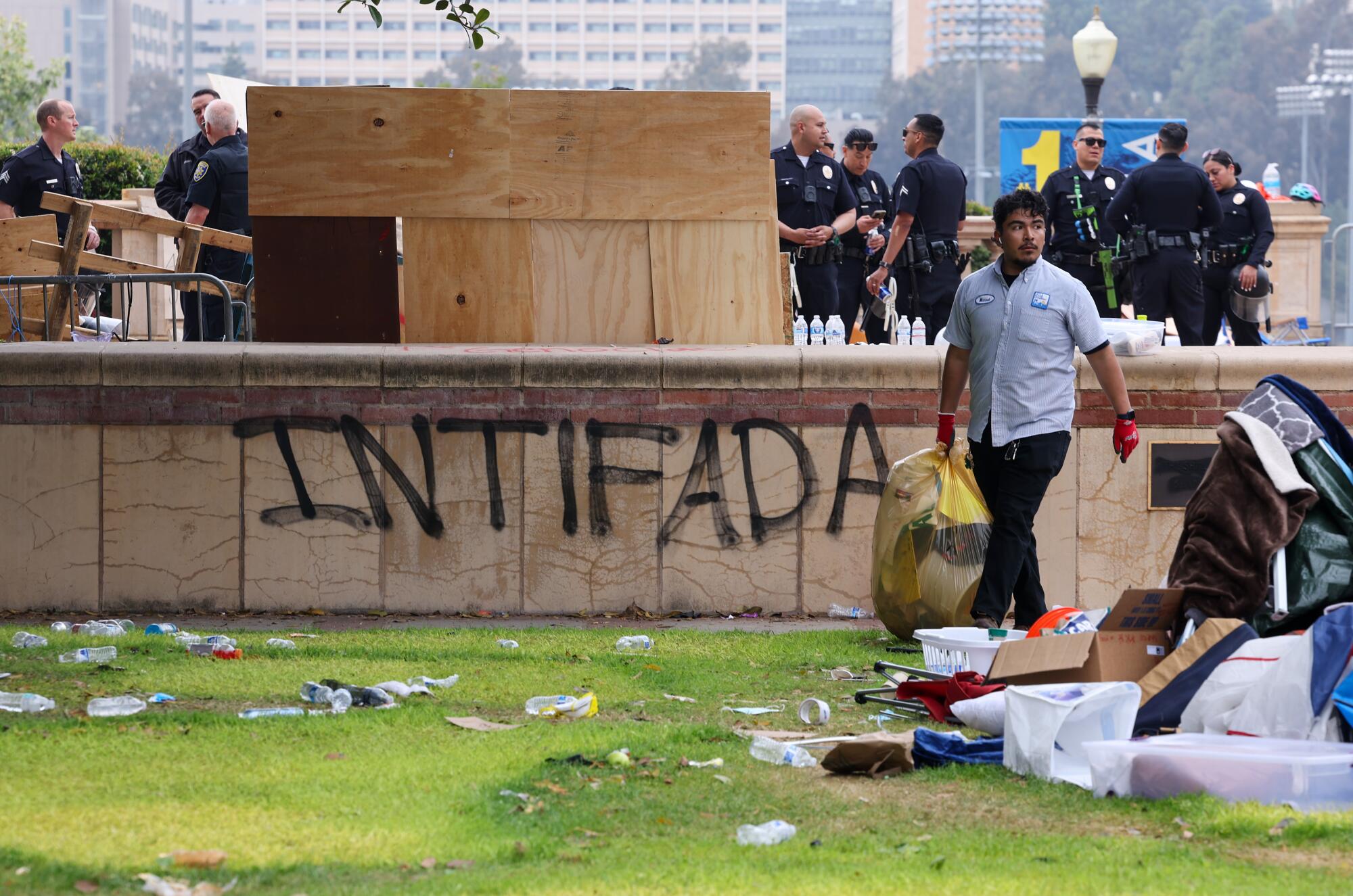
UCLA facilities employees clean up and dismantle the pro-Palestinian encampment on campus May 2.
(Brian van der Brug / Los Angeles Times)
The camp and its checkpoints, they said, were not hostile to Jews. Restricting fellow students from entering was just a pragmatic move to protect protesters inside from physical, verbal or emotional abuse.
“We are committed to keeping each other safe,” said Agnes Lin, 22, a fourth-year art and art history student and member of Jewish Voice for Peace. Anyone who agreed to the UC Divest Coalition’s demands and community guidelines, she said, was welcome.
“What is not welcome is Zionism,” she added. “Or anyone who actively adheres to a very violent, genocidal political ideology that is actively endangering people in Gaza right now.”
In practice, students who supported the existence of Israel were kept out — even if they opposed Israel’s right-wing government and its bombardment of Gaza.
Senior Adam Thaw, 21, said activists blocked him and others from accessing a public walkway to Powell Library.
After telling him they were not letting anyone through, a male activist eyed his Star of David necklace: “If you’re here to espouse that this is antisemitism, then you can leave.”
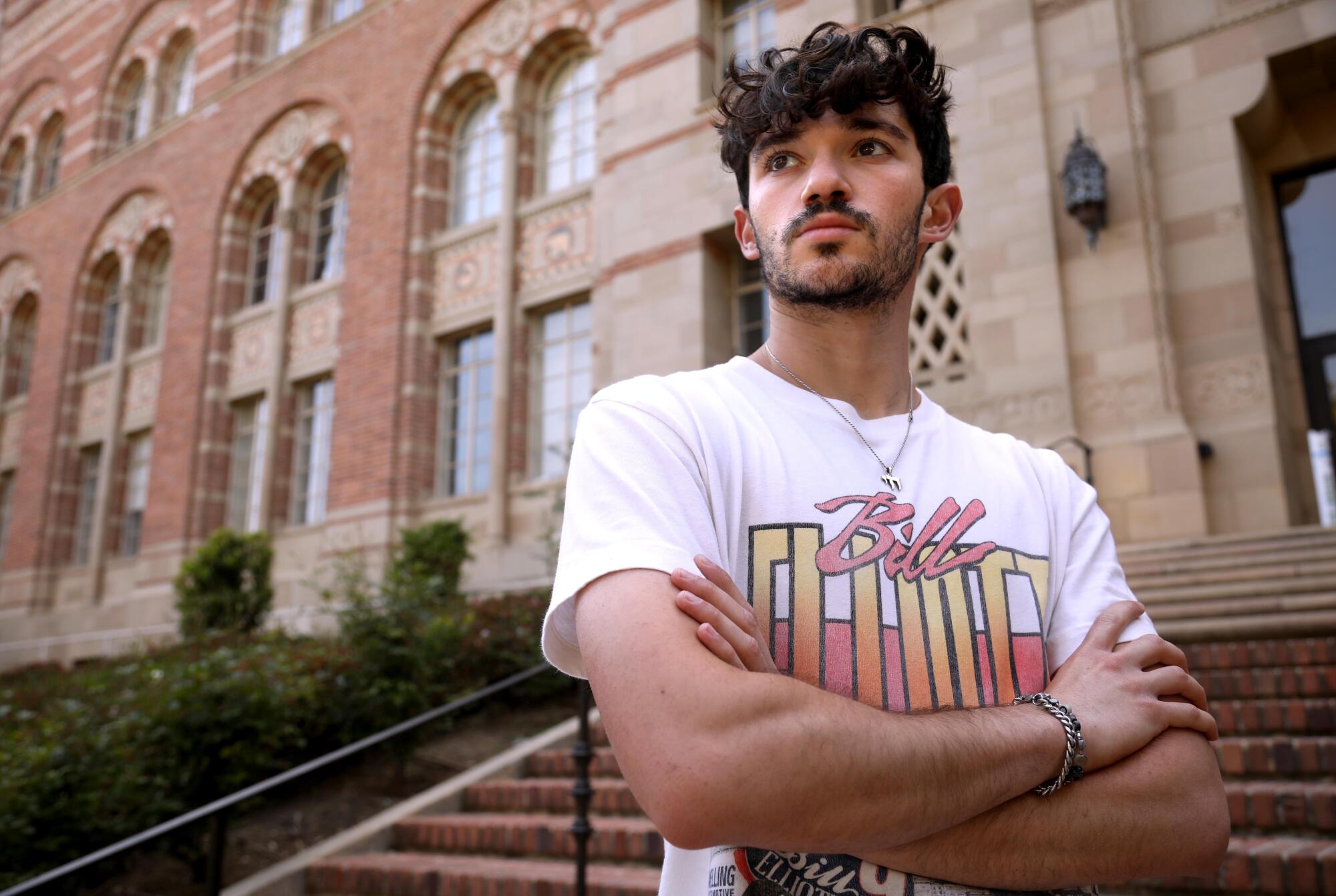
Senior Adam Thaw is on UCLA’s student board of Hillel, the largest Jewish campus organization in the world.
(Genaro Molina / Los Angeles Times)
“Who are you to tell me where I can and cannot go?” said Thaw, who is on UCLA’s student board of Hillel, the largest Jewish campus organization in the world.
As complaints from Jewish students mounted, UCLA declared the encampment “unlawful.” In an April 30 statement, Chancellor Gene Block said most activists had been peaceful, but the tactics of some were “shocking and shameful.”
“Students on their way to class,” he said, “have been physically blocked from accessing parts of the campus.”
::
The campus was dark and hushed when Sabrina Ellis joined dozens of activists at 4 a.m. to set up the encampment on the lawn of Dickson Court.
After pitching tents and erecting barricades of wooden pallets and sheets of plywood, Ellis, a 21-year-old international student from Brazil, took shifts guarding the entrance.
Ellis didn’t call it a checkpoint. The goal was to exclude and physically block “agitators” — anyone who might be violent, record students or disagree with the cause.
“Our top priority isn’t people’s freedom of movement,” Ellis said. “It is keeping people in our encampments physically and emotionally safe.”
The longtime member of Jewish Voice for Peace — who wore a large Star of David over her T-shirt and a kaffiyeh wrapped around her shoulders — said the camp “was not profiling based on religion.”
But as activists blocked Zionist students from public campus space, they faced charges that they engaged in viewpoint discrimination.
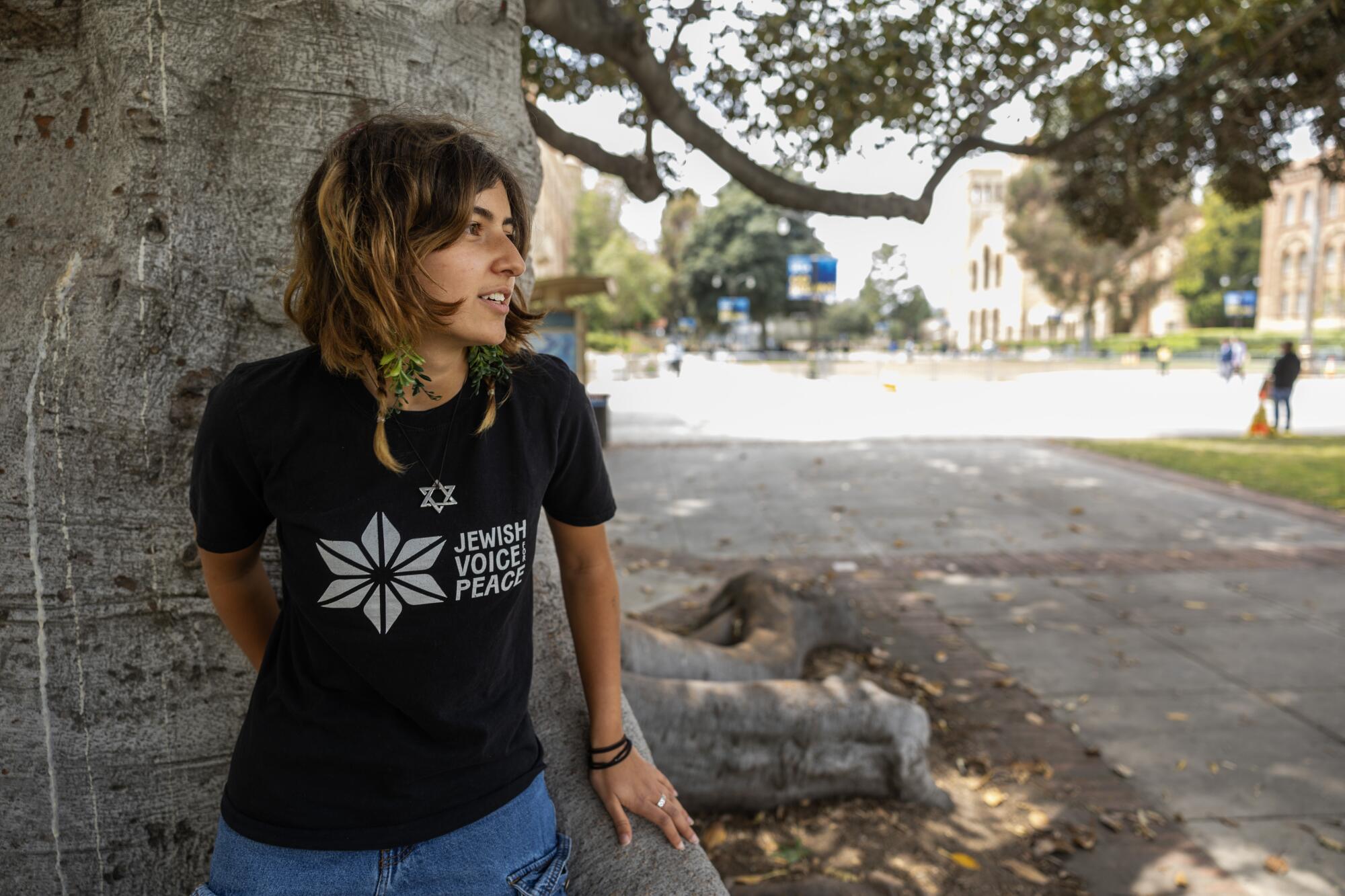
Sabrina Ellis, a junior and a member of Jewish Voice for Peace at UCLA, was part of the pro-Palestinian encampment from the beginning.
(Myung J. Chun / Los Angeles Times)
Before allowing anyone in, Ellis said, a protester read the demands of the encampment, which included calling for UC and UCLA to divest all funds from companies “complicit in the Israeli occupation,” boycott all connections with Israeli universities, sever ties with the Los Angeles Police Department and demand a permanent cease-fire.
Then, activists ran through their safety guidelines: Ask before taking a photo or video; wear a mask to limit the spread of COVID; do not post identifying information or photos; and no engagement with counterprotesters.
If students didn’t agree, “we would just kindly tell them that they’re not allowed to come in,” Ellis said.
Some Jewish students were shaken by the experience, arriving at Hillel upset and even crying.
“They were genuinely going about their day and couldn’t get access as protesters asked them, ‘Are you a Zionist?’ or looked at their necklace,” said Daniel Gold, executive director of Hillel at UCLA.
::
For pro-Palestinian activists who are Jewish, the camp was a peaceful space to promote justice, a welcoming interfaith community with therapist-led processing circles and candlelit prayer services.
Blue tarps and blankets were put down in the middle of the lawn for Islamic prayers and a Passover Seder and a Shabbat service.
On the first evening, about 100 activists, many Jewish, sat in a circle to pray, sing, drink grape juice and eat matzo ball soup, matzo crackers and watermelon.
“It was really beautiful,” said Lin, the art major. “We were trying to hold these spaces to show that Judaism goes beyond Zionism.”

An encampment of pro-Palestinian demonstrators at UCLA’s Dickson Plaza on April 29.
(Brian van der Brug / Los Angeles Times)
Other Jewish students were more wary as they navigated the camp.
Presman, who moved to the U.S. when he was 12 and identifies as a Zionist, was alarmed when he scanned the quad on the first day. He saw signs saying “Israelis are native 2 HELL,” he said, and banners and graffiti showing inverted red triangles, a symbol used in Hamas propaganda videos to indicate a military target.
“Do people know what that means?” he wondered.
Tucking his Star of David under his T-shirt, Presman said, he entered and approached activists, introducing himself as an Israeli citizen.
“Maybe we can find common ground,” he said, asking, “one human being to the other?”
Some students put their hands up, he said, blocking him as they walked away. Others treated the conversation as a joke. One protester, he said, told him that everything Hamas did was justified.
Presman said he had one good conversation: An activist who identified as anti-Zionist admitted not being 100% educated on what Zionism was, but agreed that Israel should exist. They came to the conclusion the activist was a Zionist.

Pro-Palestinian encampment participants reinforce the camp barriers at UCLA on May 1.
(Brian van der Brug / Los Angeles Times)
But most of Presman’s exchanges, he said, ended negatively when activists realized he was defending Zionism. He said he was called a “dirty Jew” and “white colonizer.”
Other students — even those who did not fully support the encampment — said they did not experience such slurs.
Rachel Burnett, a senior who described herself as a non-Zionist Jew, disagreed with the call for divestment and academic boycotts, especially of UCLA’s Nazarian Center, an educational center for the study of Israeli history, politics and culture.
Entering the camp after a classmate vouched for her, Burnett was disturbed by anti-Israeli signs and graffiti that named Abu Ubaida, the spokesperson for the military wing of Hamas. But she also bonded with protesters, including a woman in a hijab.
“Of course, some protesters deny Oct. 7 or condone violence as long as it can be put under the guise of decolonial resistance, which is obviously horrific,” Burnett said. “But that’s not the case of many students inside the encampment.”
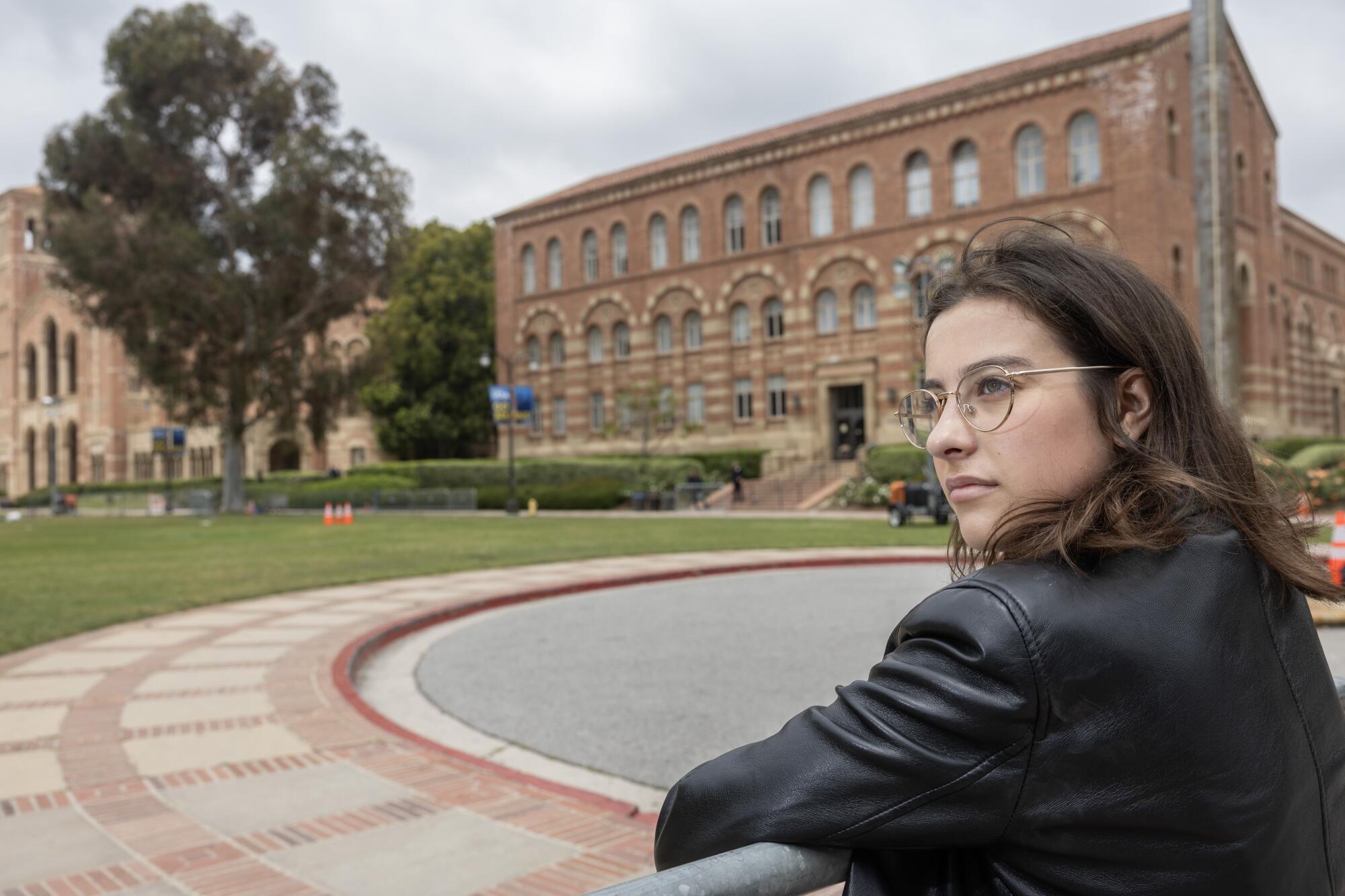
Rachel Burnett, a senior who described herself as a non-Zionist Jew, disagreed with the call for divestment and academic boycotts, especially of UCLA’s Nazarian Center, an educational center for the study of Israeli history, politics and culture.
(Myung J. Chun / Los Angeles Times)
Burnett contrasted what she saw as a peaceful, friendly mood inside the camp with the pro-Israel counterprotests where people held up benign slogans, such as “Bring the Hostages Home,” but engaged in hostile behavior.
As counterprotesters converged for a Sunday rally, she said, a pro-Israel activist spat on her and told she should have been slaughtered in the kibbutzim on Oct. 7.
Just as some pro-Palestinian activists demonized all Zionists as evil and pro-genocide — ignoring the wide range of viewpoints within the Zionist community — Burnett thought some pro-Israel counterprotesters were dehumanizing student activists in the encampment and spreading a “mass hysteria narrative.”
As the encampment expanded — and organizers set up entrance points near Royce Hall and Powell Library — some Jewish students took videos that swiftly went viral.
“It’s time to go,” a protester wearing a yellow safety vest and kaffiyeh told a student in one video as he guarded an entrance near Powell Library. “You don’t have a wristband.”
A standoff ensued.
“Are you a Zionist?” the protester asked.
“Of course I’m Zionist,” the student replied.
“Yeah, we don’t let Zionists inside.”
World News
Should London become a 'sponge city'?

Surface flooding is one of London’s biggest threats – so what can be done to combat it?
Source link
World News
Unconfirmed sighting of mountain lion in Griffith Park recalls L.A.’s favorite big cat, P-22

The mountain lion was caught in the Tesla’s headlights. Vladimir Polumiskov moved both quickly and slowly, not wanting to draw unwanted attention.
He put his 2-year-old son back in the car seat and got behind the wheel and quietly closed the door. His wife, Anastasiia Prokopenko, was in the passenger seat; she couldn’t believe what they were seeing.
“No way. No way,” she said. “Get in the car. Get in the car.”
The family, just back from a sushi dinner on Tuesday night, had pulled into a parking space at their apartment complex off Barham Boulevard in the Hollywood Hills. Living on the western edge of Griffith Park, they were accustomed to seeing wildlife — coyotes, bobcats, deer, foxes — wandering into their backyard. But a mountain lion was extreme.
“We’re not getting out,” Prokopenko said.
Less than 13 feet away, the cat was sitting on the low-angled trunk of an oak tree, partly hidden by weeds, his blond coat set off by the bright lights. Polumiskov, 30, reached for his phone and started shooting video.
“This guy was huge,” he said.
Though the sighting has not been confirmed by the National Park Service, which oversees the Santa Monica Mountains National Recreation Area and has also studied wildlife in the 4,000 acres of Griffith Park, the possibility of a mountain lion making its home in this island wilderness may give many Angelenos a sense of déjà vu all over again.
The mountain-lion king of Griffith Park — a cat known as P-22 — roamed these hills for 10 years. Captured in December 2022, he was euthanized after a team of doctors determined that because of internal injuries and infection, he was too sick to return to the wild.
A few months before, Polumiskov said he had seen P-22 skulking through the same parking lot before running off. “I had the same reaction then,” he said. “That doesn’t change. It was shocking.”
“Los Angeles misses P-22,” said Beth Pratt of the National Wildlife Federation, perhaps his most ardent champion.
In February 2023, Pratt helped organize at the Greek Theatre a sold-out celebration of his improbable life in Griffith Park, drawing more than 6,000 people wanting to pay their respects to the charismatic cat who, surrounded by development, freeways and cemeteries, lived peaceably in the center of Los Angeles.
Seven months later, the eighth annual official P-22 Day festival drew 15,000 attendees.
When Pratt first heard of this new sighting, she felt slightly overcome.
“It does my heart good,” she said . “It felt like P-22 had sent someone back to us — just to keep the hope alive that we hadn’t entirely banished the wildness in our lives.”
The National Park Service, which has reviewed Polumiskov’s video, is taking the claim seriously, according to spokesperson Ana Beatriz Cholo.
The park service has been studying the mountain lion population in the Santa Monica Mountains since 2002, when it collared its first cougar, which was given the name P-1 (P is for puma). Since then, it has tracked and collared 121 of the animals throughout the park.
If collared, the big cat in last week’s video would be P-122.
Video of a mountain lion spotted on Tuesday near Barnham Boulevard in Toluca Hills, new Hollywood. (Vladmir Polumisko)
“I’m a scientist at heart, but there is something almost mystical about this,” said Pratt, referring to the coincidental possibility that the two cats in Griffith Park would share so similar a number.
Park Service researchers are conducting interviews and combing through footage from wildlife cameras positioned throughout Griffith Park.
“We obviously want to make sure we confirm this is the real thing,” Cholo said. “Hopefully we’ll get that in the near future.”
But hope aside, she added, there is no guarantee that the mountain lion will stick around. Pumas need up to 200 square miles of habitat, and Griffith Park offers a little more than eight.
After shooting the video, Polumiskov put the Tesla in reverse and found another parking space far away from the mountain lion. Two hours later, he returned with a friend, and the cat was still there.
“He was still sitting in that tree, looking at us,” he said. “He is a beautiful, beautiful animal, young and healthy, perhaps the biggest mountain lion I’ve seen in my life.”
Four months earlier, Polumiskov had seen — while driving — what he believed was also a mountain lion. But without evidence, his family and friends doubted him. Now he had something more tangible.
The next day, he got a call from Jeff Sikich, a wildlife biologist and mountain lion specialist with the park service, who asked him a few simple questions — where and when — and reminded him to play it safe.
“He definitely educated me,” Polumiskov said.
“While it is exciting to see a wild animal,” said Cholo, “if you see a mountain lion, give it space. Don’t follow it. As tempting as it might be, this is a big cat and its behavior can be unpredictable.”
The total number of mountain lions in California is estimated to be between 3,200 and 4,500. About a dozen of the cats are said to live in the Santa Monica Mountains, and they are at risk for extinction because of low genetic diversity.
The current construction of a wildlife corridor over a 10-lane stretch of the 101 Freeway at Liberty Canyon in Agoura Hills promises to be a critical lifeline for the endangered species. When completed in 2026, it will be the largest — 200 feet long and 165 feet wide — and most expensive bridge of its kind in the world.
“The Wallis Annenberg Wildlife Crossing is critical” for the survival of the species, Pratt said . “But Griffith Park also needs safe routes for its wildlife trying to navigate the city.”
World News
Former CIA director reacts to Stefanik’s remarks about ‘wiping’ Hamas ‘off the face of the Earth’
House GOP Conference Chair Elise Stefanik delivered remarks at the Israeli Knesset Sunday, saying victory for Israel in the war against Hamas starts with “wiping” those responsible for the October 7 terrorist attacks “off the face of the Earth” and calling for a return to former President Donald Trump’s policies. Former CIA director Leon Panetta reacts.
-

 African History4 months ago
African History4 months agoBlack History Facts I had to Learn on My Own pt.6 📜
-

 African History4 years ago
African History4 years agoA Closer Look: Afro-Mexicans 🇲🇽
-

 African History1 year ago
African History1 year agoPROOF AFRICAN AMERICANS AIN'T FROM AFRICA DOCUMENTED EVIDENCE
-

 African History2 years ago
African History2 years agoHow Did Normal Medieval People Survive Winter? | Tudor Monastery Farm | Chronicle
-

 African History4 years ago
African History4 years agoA Closer Look: Afro-Mexicans 🇲🇽
-

 African History3 years ago
African History3 years agoWhat happened to the many African Kingdoms? History of Africa 1500-1800 Documentary 1/6
-

 African History3 years ago
African History3 years agoThe Entire History of Africa in Under 10 Minutes – Documentary
-

 African History2 years ago
African History2 years agoAFRO MEXICO: Black History In Mexico!





